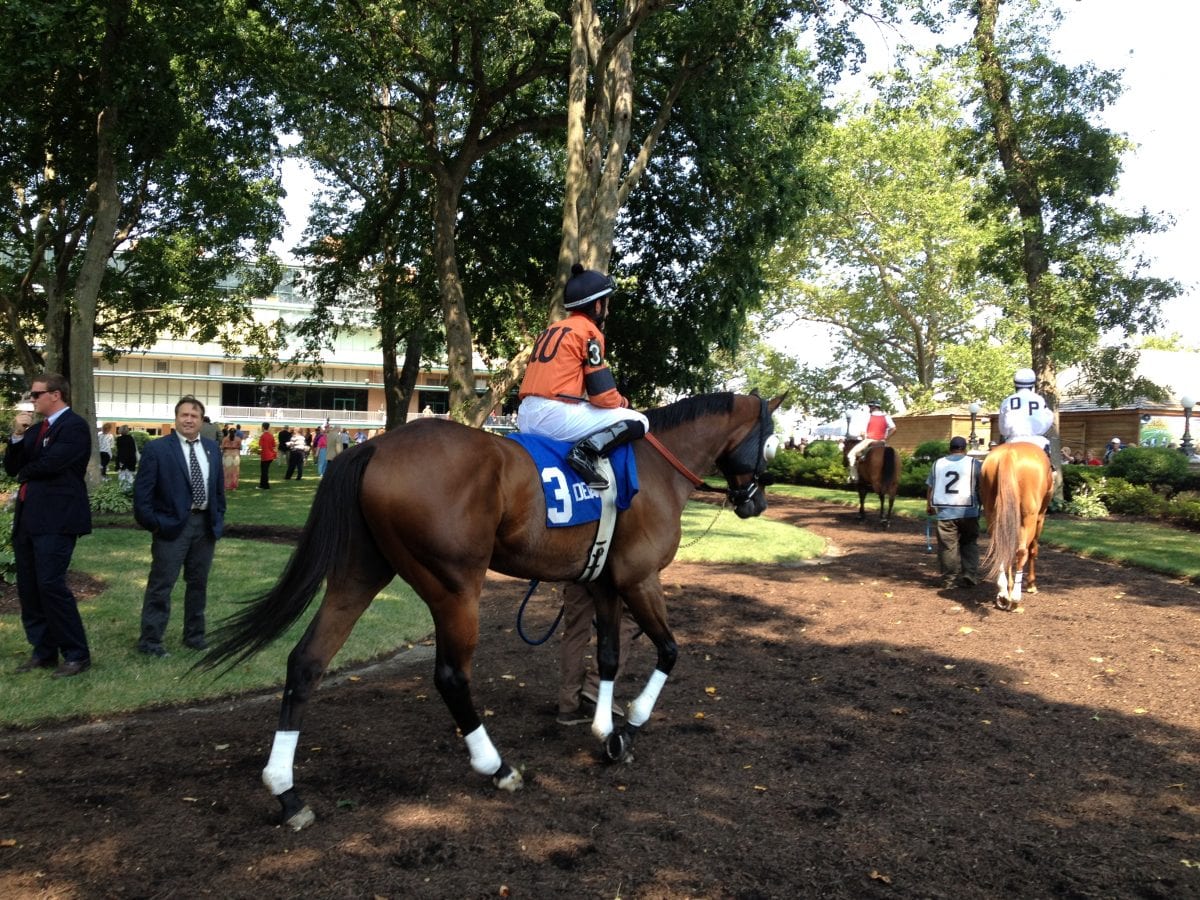5 things we learned at the mid-Atlantic regulators meeting

Delaware Park Paddock.
by Frank Vespe
More than 100 people came out to Tuesday’s “Mid-Atlantic Regulatory and Stakeholders Meeting ” at the White Clay Creek Country Club on the grounds of Delaware Park: racing Commissioners and their staffs, horsemen, racetrack operators, and even a lone media member. Who let that guy — me — in anyway?
It was a packed, all-day agenda. Here are five things we learned:
It’s pretty rare for a horse to come back with a positive drug test, at least in the mid-Atlantic.
- States in the region (including New York) spent $9.6 million on drug tests, according to meeting organizer Alan Foreman’s presentation. They tested just shy of 50,000 samples — at an average cost of about $200 per — and came back with 236 positives. That’s a positive rate of not quite 5-per-1,000 — less than one-half of one percent. Of those, according to Foreman’s stats, more than half were for Class 4 or Class 5 drugs — the least serious kind.
- Those stats led Foreman to wonder if the industry is “devoting too much of our dollars” to catching minor violations, rather than focusing on the ever-evolving world of new performance-enhancing drugs. One vet agreed, suggesting, “We’re catching people that don’t need to be caught.” And Dr. George Maylin, underlining the importance of ongoing research, likened finding unknown drugs to locating “a needle in a haystack.”
Some folks believe that horse racing should adopt one practice common in human sports, that of the “therapeutic use exemption.”
- A therapeutic use exemption allows an athlete to take an otherwise prohibited medication if it is to treat an illness or condition.
- But Ed Martin, of the Association of Racing Commissioners International, warned that such a move “would be a sea change” in the sport’s regulatory scheme. What’s more, it could open the industry up to additional suspicion and scrutiny.
The rate of equine fatalities has declined, somewhat significantly in the last couple years, from 1.9 per 1,000 starters in 2013 to 1.54 per 1,000 starters in 2016.
- In the mid-Atlantic, the rate of fatalities has declined from about 2.4 per 1,000 starts in 2010 to around 1.4 last year, Dr. Scott Palmer said; it’s the first year that the rate regionally was below the national rate.
- Why? That’s the key question everyone would like to answer. But Dr. Tim Parkin suggested that, while some factors are known, others simply are not.
- In 2016, for example, the number of races run on “off dirt” — that is, dirt tracks that were not rated fast — declined, presumably as a result of fewer days of precipitation. That accounted, Parkin said, for 6.5 percent of the drop in fatal breakdowns. But analysts have not been able to tease out the reasons behind 65 percent of the reduction, leaving a lot of questions as yet unanswered.
- Some of the data raise interesting policy questions. For example, Parkin said that a horse’s first race after a trainer switch is “its highest-risk race.” How should the industry deal with that?
Uniformity isn’t always uniform.
- The mid-Atlantic region has made a great deal of progress in harmonizing medication rules from state to state in recent years; in fact, the Racing Medication and Testing Consortium lists all six of the region’s states — Delaware, Maryland, New Jersey, Pennsylvania, Virginia, and West Virginia — as having adopted all of the tenets of the national uniform medication program. Those are: a list of controlled therapeutic substances, with all others prohibited; the use of accredited laboratories for drug testing; third-party Lasix administration; and a multiple medication violation point system.
- But some horsemen say that uniformity doesn’t always seem to be uniform, and that changes in testing levels from state to state — or within a state — can lead to varying results. Pennsylvania, for example, recorded 92 of the 236 medication positives in the region, which one horsemen attributed to the state’s testing changing to “a much more sensitive apparatus.”
- As reported by The Racing Biz, Maryland in June upgraded its testing to “graded stakes” quality testing, which entails testing for a broader spectrum of drugs. Some of the states in the region follow similar protocol, while others do not.
- “How are we supposed to keep up on that?” one horseman wondered.
Folks hoping for national legislation to centralize medication rules and enforcement in a single national body probably shouldn’t hold their breath.
- Rep. Tom Rooney (R-FL), a horse owner and grandson of Pittsburgh Steelers founder Art Rooney, addressed the group at lunch. Rooney said that he had a hard time envisioning a scenario where the Congress would take action on racing rules, even were the industry united behind such a change. Rooney has been vocal about his frustration with his party’s recent failure to reform health care, telling The Atlantic that he was “wracking my brain to think of one thing our party has done that’s been something positive.” If Republicans couldn’t come together on an issue on which virtually all of them had run, he suggested, it’s not likely — and possibly not desirable — that the Congress would unite to force a national solution on a reluctant racing industry.













Did Allen report on all the positives at Ct so far this year? Like 3 a week all from the receiving barn .
Great reporting, as usual from this site. I agree with the concept that the worst cheating is done by some of the biggest names – names that are able to underwrite the costs of their own labs to fabricate designer drugs that are undetectable to routine testing. How can you beat them? A good question, worthy of its own article and reporting. Cracking down on positives for ucler medications isn’t doing much to ensure integrity in the sport. It does keep paperwork spinning and bureaucrats able to justify their salaries, however.